Life Cycle Thinking: Sustainability Analysis of the Milk Industry
VerifiedAdded on 2020/01/23
|14
|4461
|459
Case Study
AI Summary
This case study explores the application of life cycle thinking to improve the sustainability of the milk industry. It begins with an introduction to life cycle thinking and its role in enhancing environmental, social, and economic sustainability. The study then examines the various stages of milk production, from farm gate to consumption, and analyzes how each stage impacts sustainability. It emphasizes the importance of functional units and stakeholder considerations, including customers, in the life cycle. The study also addresses how sustainability reports can be modified to cater to different stakeholders. The analysis covers key aspects like resource allocation, waste management, and the implementation of environmental policies to promote sustainable development. The case study highlights the significance of life cycle assessment (LCA) in identifying and mitigating environmental impacts, improving operational efficiency, and enhancing product quality. The importance of considering functional units, such as feed, electricity, and packaging, to promote sustainability is also highlighted, along with the role of refrigeration and distribution. The study concludes by emphasizing the need for aligning life cycle thinking with stakeholder needs and expectations to ensure long-term sustainability.
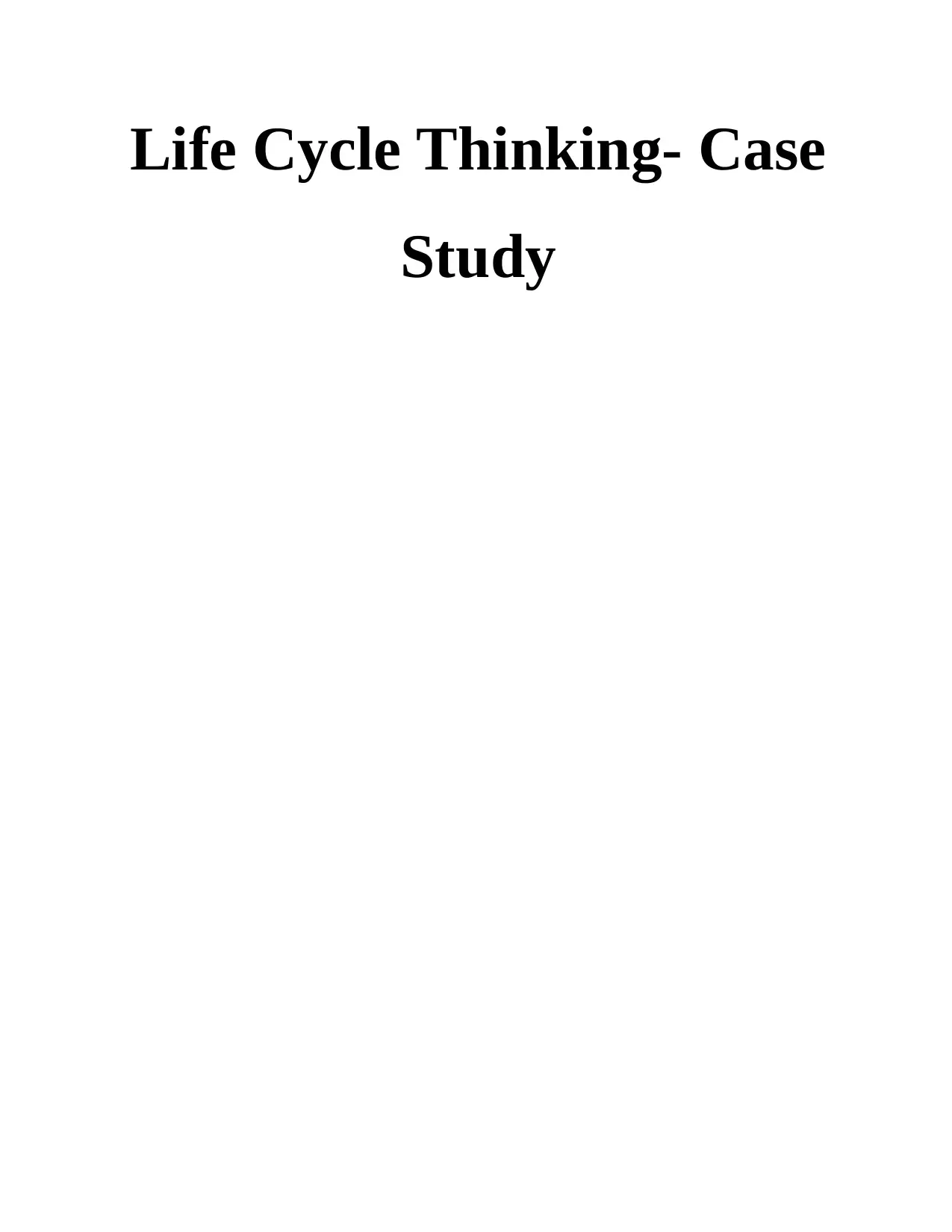
Life Cycle Thinking- Case
Study
Study
Paraphrase This Document
Need a fresh take? Get an instant paraphrase of this document with our AI Paraphraser
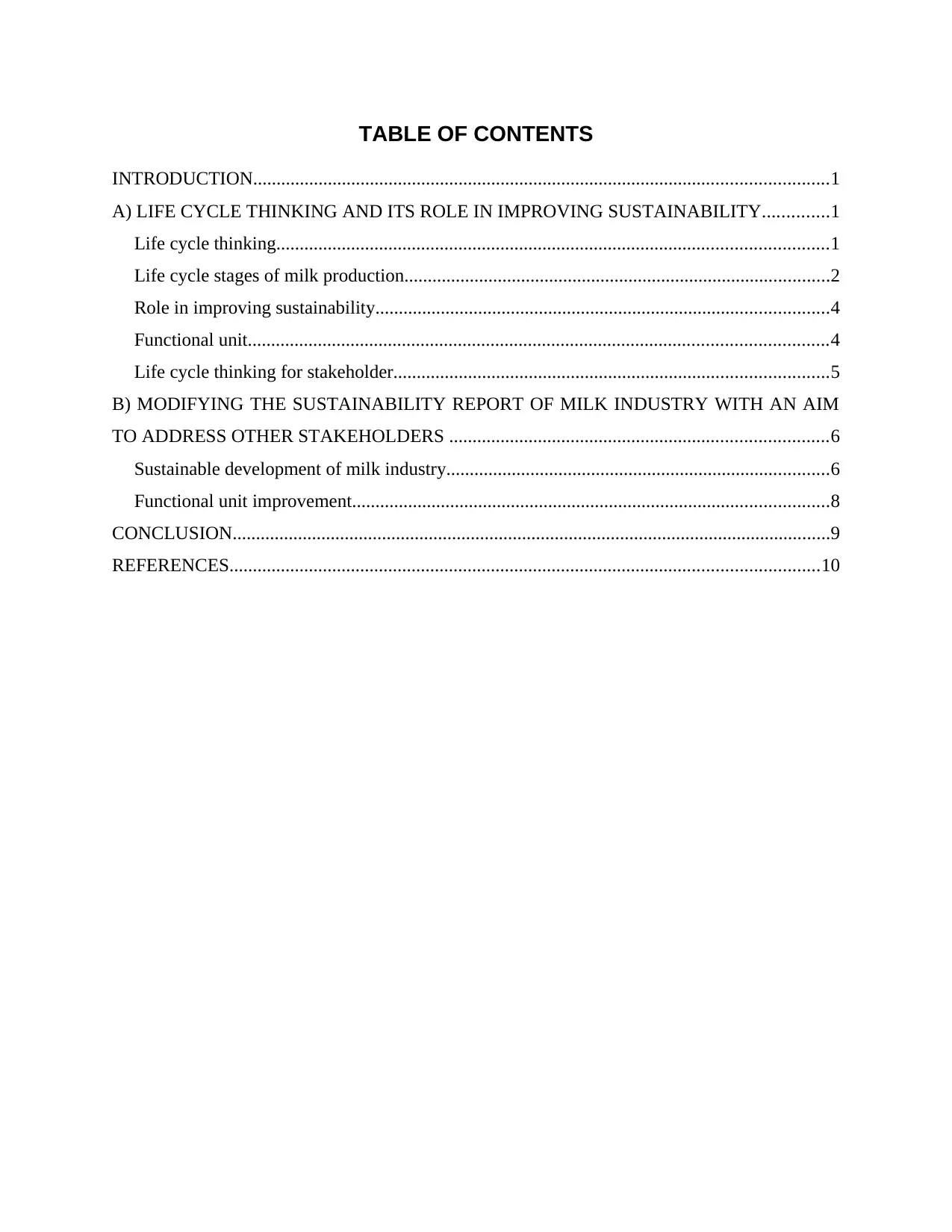
TABLE OF CONTENTS
INTRODUCTION...........................................................................................................................1
A) LIFE CYCLE THINKING AND ITS ROLE IN IMPROVING SUSTAINABILITY..............1
Life cycle thinking......................................................................................................................1
Life cycle stages of milk production...........................................................................................2
Role in improving sustainability.................................................................................................4
Functional unit............................................................................................................................4
Life cycle thinking for stakeholder.............................................................................................5
B) MODIFYING THE SUSTAINABILITY REPORT OF MILK INDUSTRY WITH AN AIM
TO ADDRESS OTHER STAKEHOLDERS .................................................................................6
Sustainable development of milk industry..................................................................................6
Functional unit improvement......................................................................................................8
CONCLUSION................................................................................................................................9
REFERENCES..............................................................................................................................10
INTRODUCTION...........................................................................................................................1
A) LIFE CYCLE THINKING AND ITS ROLE IN IMPROVING SUSTAINABILITY..............1
Life cycle thinking......................................................................................................................1
Life cycle stages of milk production...........................................................................................2
Role in improving sustainability.................................................................................................4
Functional unit............................................................................................................................4
Life cycle thinking for stakeholder.............................................................................................5
B) MODIFYING THE SUSTAINABILITY REPORT OF MILK INDUSTRY WITH AN AIM
TO ADDRESS OTHER STAKEHOLDERS .................................................................................6
Sustainable development of milk industry..................................................................................6
Functional unit improvement......................................................................................................8
CONCLUSION................................................................................................................................9
REFERENCES..............................................................................................................................10
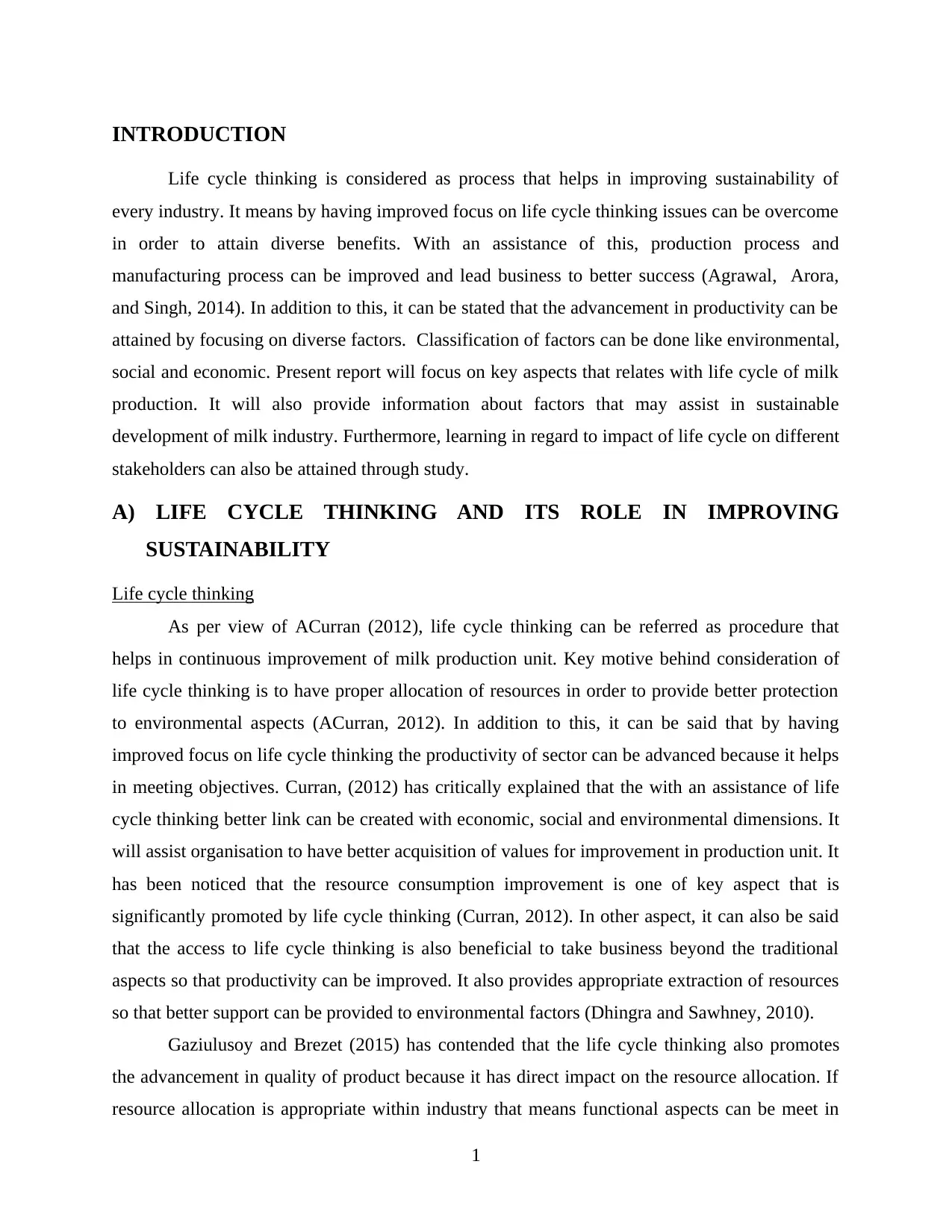
INTRODUCTION
Life cycle thinking is considered as process that helps in improving sustainability of
every industry. It means by having improved focus on life cycle thinking issues can be overcome
in order to attain diverse benefits. With an assistance of this, production process and
manufacturing process can be improved and lead business to better success (Agrawal, Arora,
and Singh, 2014). In addition to this, it can be stated that the advancement in productivity can be
attained by focusing on diverse factors. Classification of factors can be done like environmental,
social and economic. Present report will focus on key aspects that relates with life cycle of milk
production. It will also provide information about factors that may assist in sustainable
development of milk industry. Furthermore, learning in regard to impact of life cycle on different
stakeholders can also be attained through study.
A) LIFE CYCLE THINKING AND ITS ROLE IN IMPROVING
SUSTAINABILITY
Life cycle thinking
As per view of ACurran (2012), life cycle thinking can be referred as procedure that
helps in continuous improvement of milk production unit. Key motive behind consideration of
life cycle thinking is to have proper allocation of resources in order to provide better protection
to environmental aspects (ACurran, 2012). In addition to this, it can be said that by having
improved focus on life cycle thinking the productivity of sector can be advanced because it helps
in meeting objectives. Curran, (2012) has critically explained that the with an assistance of life
cycle thinking better link can be created with economic, social and environmental dimensions. It
will assist organisation to have better acquisition of values for improvement in production unit. It
has been noticed that the resource consumption improvement is one of key aspect that is
significantly promoted by life cycle thinking (Curran, 2012). In other aspect, it can also be said
that the access to life cycle thinking is also beneficial to take business beyond the traditional
aspects so that productivity can be improved. It also provides appropriate extraction of resources
so that better support can be provided to environmental factors (Dhingra and Sawhney, 2010).
Gaziulusoy and Brezet (2015) has contended that the life cycle thinking also promotes
the advancement in quality of product because it has direct impact on the resource allocation. If
resource allocation is appropriate within industry that means functional aspects can be meet in
1
Life cycle thinking is considered as process that helps in improving sustainability of
every industry. It means by having improved focus on life cycle thinking issues can be overcome
in order to attain diverse benefits. With an assistance of this, production process and
manufacturing process can be improved and lead business to better success (Agrawal, Arora,
and Singh, 2014). In addition to this, it can be stated that the advancement in productivity can be
attained by focusing on diverse factors. Classification of factors can be done like environmental,
social and economic. Present report will focus on key aspects that relates with life cycle of milk
production. It will also provide information about factors that may assist in sustainable
development of milk industry. Furthermore, learning in regard to impact of life cycle on different
stakeholders can also be attained through study.
A) LIFE CYCLE THINKING AND ITS ROLE IN IMPROVING
SUSTAINABILITY
Life cycle thinking
As per view of ACurran (2012), life cycle thinking can be referred as procedure that
helps in continuous improvement of milk production unit. Key motive behind consideration of
life cycle thinking is to have proper allocation of resources in order to provide better protection
to environmental aspects (ACurran, 2012). In addition to this, it can be said that by having
improved focus on life cycle thinking the productivity of sector can be advanced because it helps
in meeting objectives. Curran, (2012) has critically explained that the with an assistance of life
cycle thinking better link can be created with economic, social and environmental dimensions. It
will assist organisation to have better acquisition of values for improvement in production unit. It
has been noticed that the resource consumption improvement is one of key aspect that is
significantly promoted by life cycle thinking (Curran, 2012). In other aspect, it can also be said
that the access to life cycle thinking is also beneficial to take business beyond the traditional
aspects so that productivity can be improved. It also provides appropriate extraction of resources
so that better support can be provided to environmental factors (Dhingra and Sawhney, 2010).
Gaziulusoy and Brezet (2015) has contended that the life cycle thinking also promotes
the advancement in quality of product because it has direct impact on the resource allocation. If
resource allocation is appropriate within industry that means functional aspects can be meet in
1
⊘ This is a preview!⊘
Do you want full access?
Subscribe today to unlock all pages.

Trusted by 1+ million students worldwide
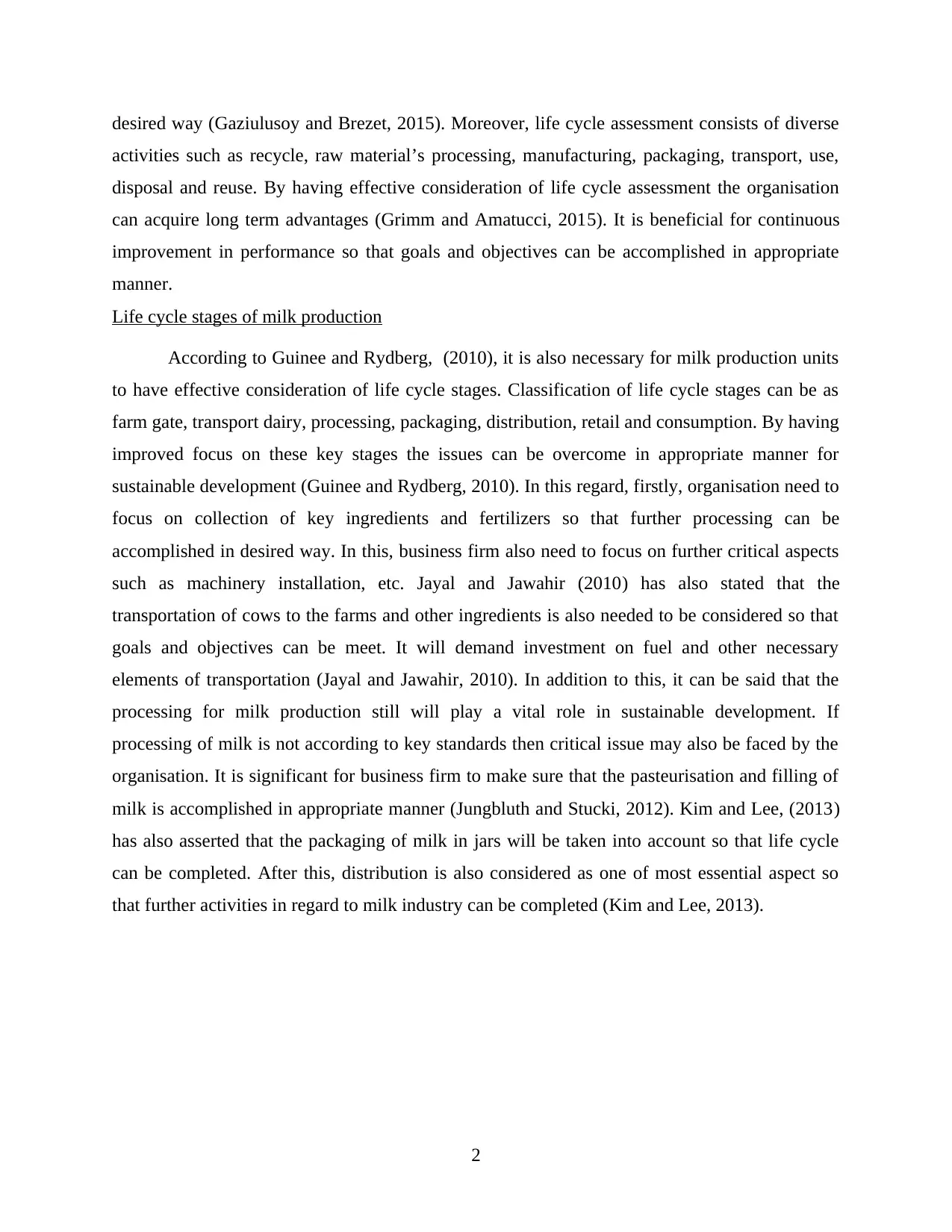
desired way (Gaziulusoy and Brezet, 2015). Moreover, life cycle assessment consists of diverse
activities such as recycle, raw material’s processing, manufacturing, packaging, transport, use,
disposal and reuse. By having effective consideration of life cycle assessment the organisation
can acquire long term advantages (Grimm and Amatucci, 2015). It is beneficial for continuous
improvement in performance so that goals and objectives can be accomplished in appropriate
manner.
Life cycle stages of milk production
According to Guinee and Rydberg, (2010), it is also necessary for milk production units
to have effective consideration of life cycle stages. Classification of life cycle stages can be as
farm gate, transport dairy, processing, packaging, distribution, retail and consumption. By having
improved focus on these key stages the issues can be overcome in appropriate manner for
sustainable development (Guinee and Rydberg, 2010). In this regard, firstly, organisation need to
focus on collection of key ingredients and fertilizers so that further processing can be
accomplished in desired way. In this, business firm also need to focus on further critical aspects
such as machinery installation, etc. Jayal and Jawahir (2010) has also stated that the
transportation of cows to the farms and other ingredients is also needed to be considered so that
goals and objectives can be meet. It will demand investment on fuel and other necessary
elements of transportation (Jayal and Jawahir, 2010). In addition to this, it can be said that the
processing for milk production still will play a vital role in sustainable development. If
processing of milk is not according to key standards then critical issue may also be faced by the
organisation. It is significant for business firm to make sure that the pasteurisation and filling of
milk is accomplished in appropriate manner (Jungbluth and Stucki, 2012). Kim and Lee, (2013)
has also asserted that the packaging of milk in jars will be taken into account so that life cycle
can be completed. After this, distribution is also considered as one of most essential aspect so
that further activities in regard to milk industry can be completed (Kim and Lee, 2013).
2
activities such as recycle, raw material’s processing, manufacturing, packaging, transport, use,
disposal and reuse. By having effective consideration of life cycle assessment the organisation
can acquire long term advantages (Grimm and Amatucci, 2015). It is beneficial for continuous
improvement in performance so that goals and objectives can be accomplished in appropriate
manner.
Life cycle stages of milk production
According to Guinee and Rydberg, (2010), it is also necessary for milk production units
to have effective consideration of life cycle stages. Classification of life cycle stages can be as
farm gate, transport dairy, processing, packaging, distribution, retail and consumption. By having
improved focus on these key stages the issues can be overcome in appropriate manner for
sustainable development (Guinee and Rydberg, 2010). In this regard, firstly, organisation need to
focus on collection of key ingredients and fertilizers so that further processing can be
accomplished in desired way. In this, business firm also need to focus on further critical aspects
such as machinery installation, etc. Jayal and Jawahir (2010) has also stated that the
transportation of cows to the farms and other ingredients is also needed to be considered so that
goals and objectives can be meet. It will demand investment on fuel and other necessary
elements of transportation (Jayal and Jawahir, 2010). In addition to this, it can be said that the
processing for milk production still will play a vital role in sustainable development. If
processing of milk is not according to key standards then critical issue may also be faced by the
organisation. It is significant for business firm to make sure that the pasteurisation and filling of
milk is accomplished in appropriate manner (Jungbluth and Stucki, 2012). Kim and Lee, (2013)
has also asserted that the packaging of milk in jars will be taken into account so that life cycle
can be completed. After this, distribution is also considered as one of most essential aspect so
that further activities in regard to milk industry can be completed (Kim and Lee, 2013).
2
Paraphrase This Document
Need a fresh take? Get an instant paraphrase of this document with our AI Paraphraser
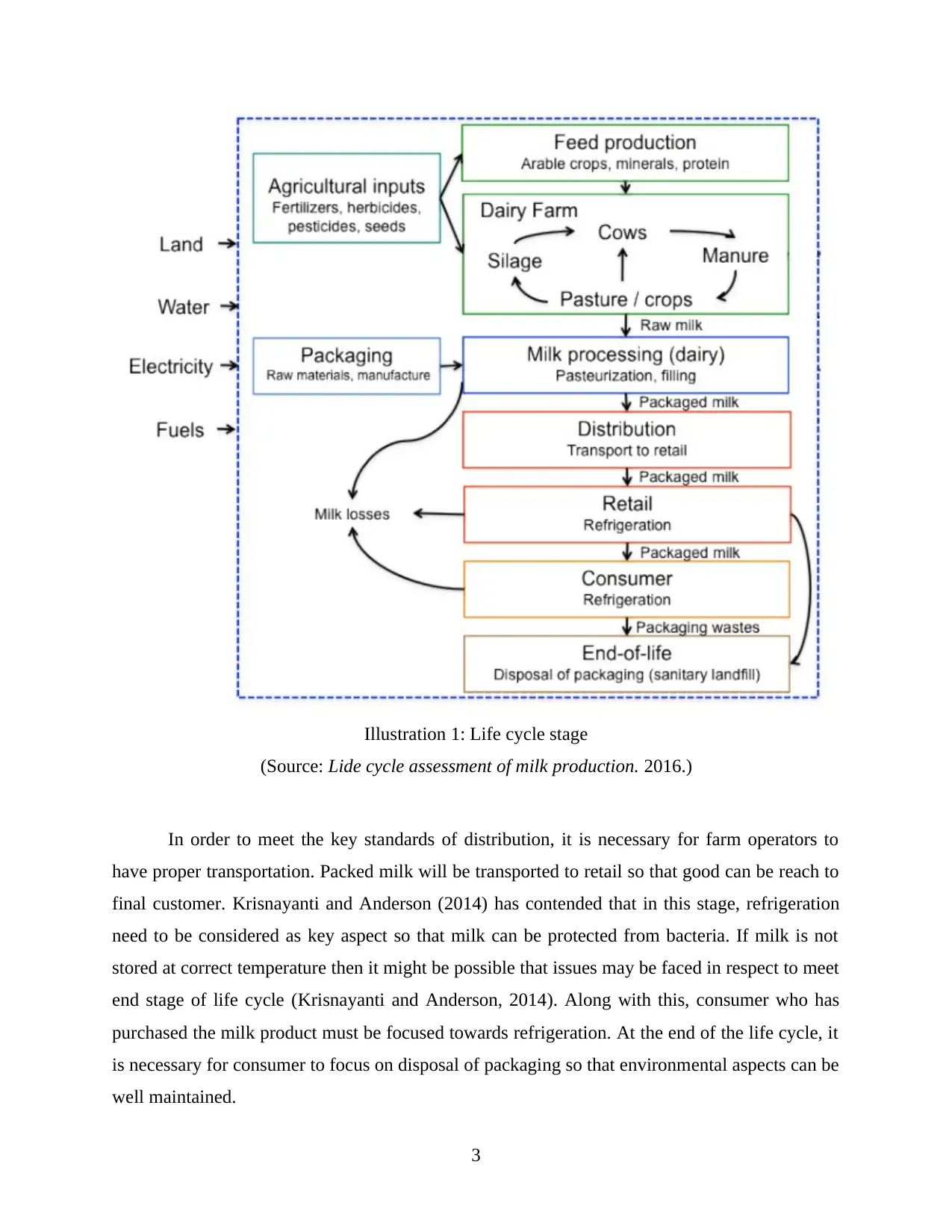
In order to meet the key standards of distribution, it is necessary for farm operators to
have proper transportation. Packed milk will be transported to retail so that good can be reach to
final customer. Krisnayanti and Anderson (2014) has contended that in this stage, refrigeration
need to be considered as key aspect so that milk can be protected from bacteria. If milk is not
stored at correct temperature then it might be possible that issues may be faced in respect to meet
end stage of life cycle (Krisnayanti and Anderson, 2014). Along with this, consumer who has
purchased the milk product must be focused towards refrigeration. At the end of the life cycle, it
is necessary for consumer to focus on disposal of packaging so that environmental aspects can be
well maintained.
3
Illustration 1: Life cycle stage
(Source: Lide cycle assessment of milk production. 2016.)
have proper transportation. Packed milk will be transported to retail so that good can be reach to
final customer. Krisnayanti and Anderson (2014) has contended that in this stage, refrigeration
need to be considered as key aspect so that milk can be protected from bacteria. If milk is not
stored at correct temperature then it might be possible that issues may be faced in respect to meet
end stage of life cycle (Krisnayanti and Anderson, 2014). Along with this, consumer who has
purchased the milk product must be focused towards refrigeration. At the end of the life cycle, it
is necessary for consumer to focus on disposal of packaging so that environmental aspects can be
well maintained.
3
Illustration 1: Life cycle stage
(Source: Lide cycle assessment of milk production. 2016.)
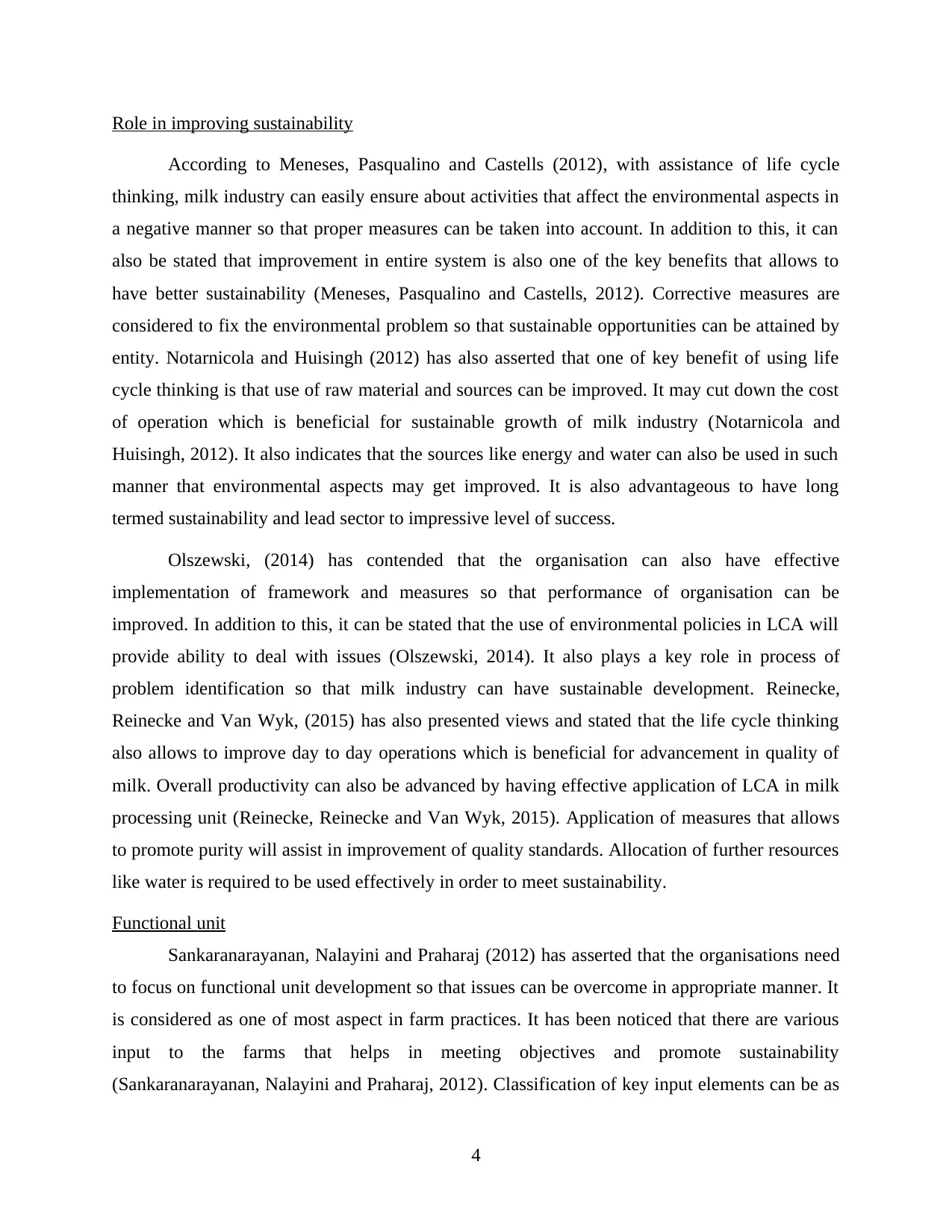
Role in improving sustainability
According to Meneses, Pasqualino and Castells (2012), with assistance of life cycle
thinking, milk industry can easily ensure about activities that affect the environmental aspects in
a negative manner so that proper measures can be taken into account. In addition to this, it can
also be stated that improvement in entire system is also one of the key benefits that allows to
have better sustainability (Meneses, Pasqualino and Castells, 2012). Corrective measures are
considered to fix the environmental problem so that sustainable opportunities can be attained by
entity. Notarnicola and Huisingh (2012) has also asserted that one of key benefit of using life
cycle thinking is that use of raw material and sources can be improved. It may cut down the cost
of operation which is beneficial for sustainable growth of milk industry (Notarnicola and
Huisingh, 2012). It also indicates that the sources like energy and water can also be used in such
manner that environmental aspects may get improved. It is also advantageous to have long
termed sustainability and lead sector to impressive level of success.
Olszewski, (2014) has contended that the organisation can also have effective
implementation of framework and measures so that performance of organisation can be
improved. In addition to this, it can be stated that the use of environmental policies in LCA will
provide ability to deal with issues (Olszewski, 2014). It also plays a key role in process of
problem identification so that milk industry can have sustainable development. Reinecke,
Reinecke and Van Wyk, (2015) has also presented views and stated that the life cycle thinking
also allows to improve day to day operations which is beneficial for advancement in quality of
milk. Overall productivity can also be advanced by having effective application of LCA in milk
processing unit (Reinecke, Reinecke and Van Wyk, 2015). Application of measures that allows
to promote purity will assist in improvement of quality standards. Allocation of further resources
like water is required to be used effectively in order to meet sustainability.
Functional unit
Sankaranarayanan, Nalayini and Praharaj (2012) has asserted that the organisations need
to focus on functional unit development so that issues can be overcome in appropriate manner. It
is considered as one of most aspect in farm practices. It has been noticed that there are various
input to the farms that helps in meeting objectives and promote sustainability
(Sankaranarayanan, Nalayini and Praharaj, 2012). Classification of key input elements can be as
4
According to Meneses, Pasqualino and Castells (2012), with assistance of life cycle
thinking, milk industry can easily ensure about activities that affect the environmental aspects in
a negative manner so that proper measures can be taken into account. In addition to this, it can
also be stated that improvement in entire system is also one of the key benefits that allows to
have better sustainability (Meneses, Pasqualino and Castells, 2012). Corrective measures are
considered to fix the environmental problem so that sustainable opportunities can be attained by
entity. Notarnicola and Huisingh (2012) has also asserted that one of key benefit of using life
cycle thinking is that use of raw material and sources can be improved. It may cut down the cost
of operation which is beneficial for sustainable growth of milk industry (Notarnicola and
Huisingh, 2012). It also indicates that the sources like energy and water can also be used in such
manner that environmental aspects may get improved. It is also advantageous to have long
termed sustainability and lead sector to impressive level of success.
Olszewski, (2014) has contended that the organisation can also have effective
implementation of framework and measures so that performance of organisation can be
improved. In addition to this, it can be stated that the use of environmental policies in LCA will
provide ability to deal with issues (Olszewski, 2014). It also plays a key role in process of
problem identification so that milk industry can have sustainable development. Reinecke,
Reinecke and Van Wyk, (2015) has also presented views and stated that the life cycle thinking
also allows to improve day to day operations which is beneficial for advancement in quality of
milk. Overall productivity can also be advanced by having effective application of LCA in milk
processing unit (Reinecke, Reinecke and Van Wyk, 2015). Application of measures that allows
to promote purity will assist in improvement of quality standards. Allocation of further resources
like water is required to be used effectively in order to meet sustainability.
Functional unit
Sankaranarayanan, Nalayini and Praharaj (2012) has asserted that the organisations need
to focus on functional unit development so that issues can be overcome in appropriate manner. It
is considered as one of most aspect in farm practices. It has been noticed that there are various
input to the farms that helps in meeting objectives and promote sustainability
(Sankaranarayanan, Nalayini and Praharaj, 2012). Classification of key input elements can be as
4
⊘ This is a preview!⊘
Do you want full access?
Subscribe today to unlock all pages.

Trusted by 1+ million students worldwide
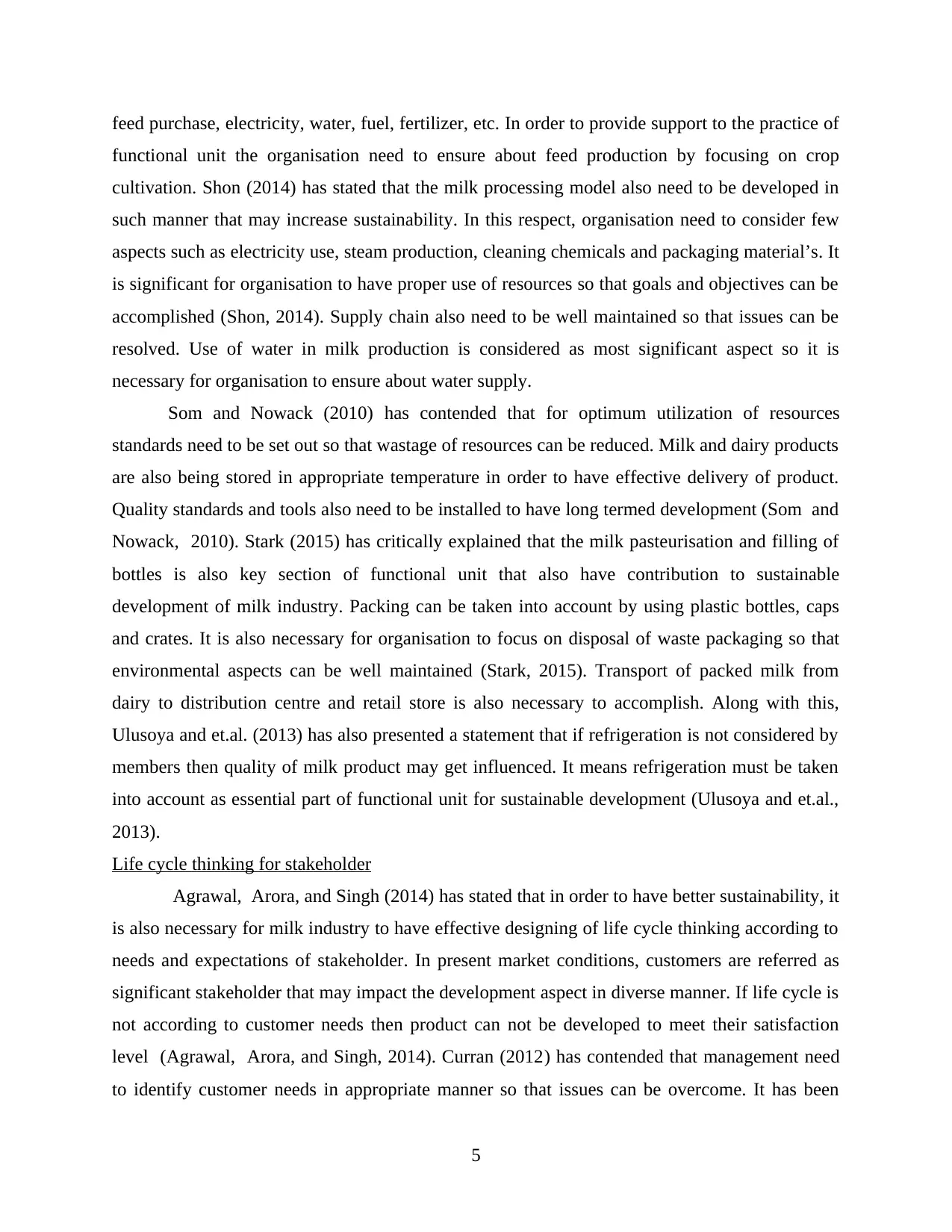
feed purchase, electricity, water, fuel, fertilizer, etc. In order to provide support to the practice of
functional unit the organisation need to ensure about feed production by focusing on crop
cultivation. Shon (2014) has stated that the milk processing model also need to be developed in
such manner that may increase sustainability. In this respect, organisation need to consider few
aspects such as electricity use, steam production, cleaning chemicals and packaging material’s. It
is significant for organisation to have proper use of resources so that goals and objectives can be
accomplished (Shon, 2014). Supply chain also need to be well maintained so that issues can be
resolved. Use of water in milk production is considered as most significant aspect so it is
necessary for organisation to ensure about water supply.
Som and Nowack (2010) has contended that for optimum utilization of resources
standards need to be set out so that wastage of resources can be reduced. Milk and dairy products
are also being stored in appropriate temperature in order to have effective delivery of product.
Quality standards and tools also need to be installed to have long termed development (Som and
Nowack, 2010). Stark (2015) has critically explained that the milk pasteurisation and filling of
bottles is also key section of functional unit that also have contribution to sustainable
development of milk industry. Packing can be taken into account by using plastic bottles, caps
and crates. It is also necessary for organisation to focus on disposal of waste packaging so that
environmental aspects can be well maintained (Stark, 2015). Transport of packed milk from
dairy to distribution centre and retail store is also necessary to accomplish. Along with this,
Ulusoya and et.al. (2013) has also presented a statement that if refrigeration is not considered by
members then quality of milk product may get influenced. It means refrigeration must be taken
into account as essential part of functional unit for sustainable development (Ulusoya and et.al.,
2013).
Life cycle thinking for stakeholder
Agrawal, Arora, and Singh (2014) has stated that in order to have better sustainability, it
is also necessary for milk industry to have effective designing of life cycle thinking according to
needs and expectations of stakeholder. In present market conditions, customers are referred as
significant stakeholder that may impact the development aspect in diverse manner. If life cycle is
not according to customer needs then product can not be developed to meet their satisfaction
level (Agrawal, Arora, and Singh, 2014). Curran (2012) has contended that management need
to identify customer needs in appropriate manner so that issues can be overcome. It has been
5
functional unit the organisation need to ensure about feed production by focusing on crop
cultivation. Shon (2014) has stated that the milk processing model also need to be developed in
such manner that may increase sustainability. In this respect, organisation need to consider few
aspects such as electricity use, steam production, cleaning chemicals and packaging material’s. It
is significant for organisation to have proper use of resources so that goals and objectives can be
accomplished (Shon, 2014). Supply chain also need to be well maintained so that issues can be
resolved. Use of water in milk production is considered as most significant aspect so it is
necessary for organisation to ensure about water supply.
Som and Nowack (2010) has contended that for optimum utilization of resources
standards need to be set out so that wastage of resources can be reduced. Milk and dairy products
are also being stored in appropriate temperature in order to have effective delivery of product.
Quality standards and tools also need to be installed to have long termed development (Som and
Nowack, 2010). Stark (2015) has critically explained that the milk pasteurisation and filling of
bottles is also key section of functional unit that also have contribution to sustainable
development of milk industry. Packing can be taken into account by using plastic bottles, caps
and crates. It is also necessary for organisation to focus on disposal of waste packaging so that
environmental aspects can be well maintained (Stark, 2015). Transport of packed milk from
dairy to distribution centre and retail store is also necessary to accomplish. Along with this,
Ulusoya and et.al. (2013) has also presented a statement that if refrigeration is not considered by
members then quality of milk product may get influenced. It means refrigeration must be taken
into account as essential part of functional unit for sustainable development (Ulusoya and et.al.,
2013).
Life cycle thinking for stakeholder
Agrawal, Arora, and Singh (2014) has stated that in order to have better sustainability, it
is also necessary for milk industry to have effective designing of life cycle thinking according to
needs and expectations of stakeholder. In present market conditions, customers are referred as
significant stakeholder that may impact the development aspect in diverse manner. If life cycle is
not according to customer needs then product can not be developed to meet their satisfaction
level (Agrawal, Arora, and Singh, 2014). Curran (2012) has contended that management need
to identify customer needs in appropriate manner so that issues can be overcome. It has been
5
Paraphrase This Document
Need a fresh take? Get an instant paraphrase of this document with our AI Paraphraser
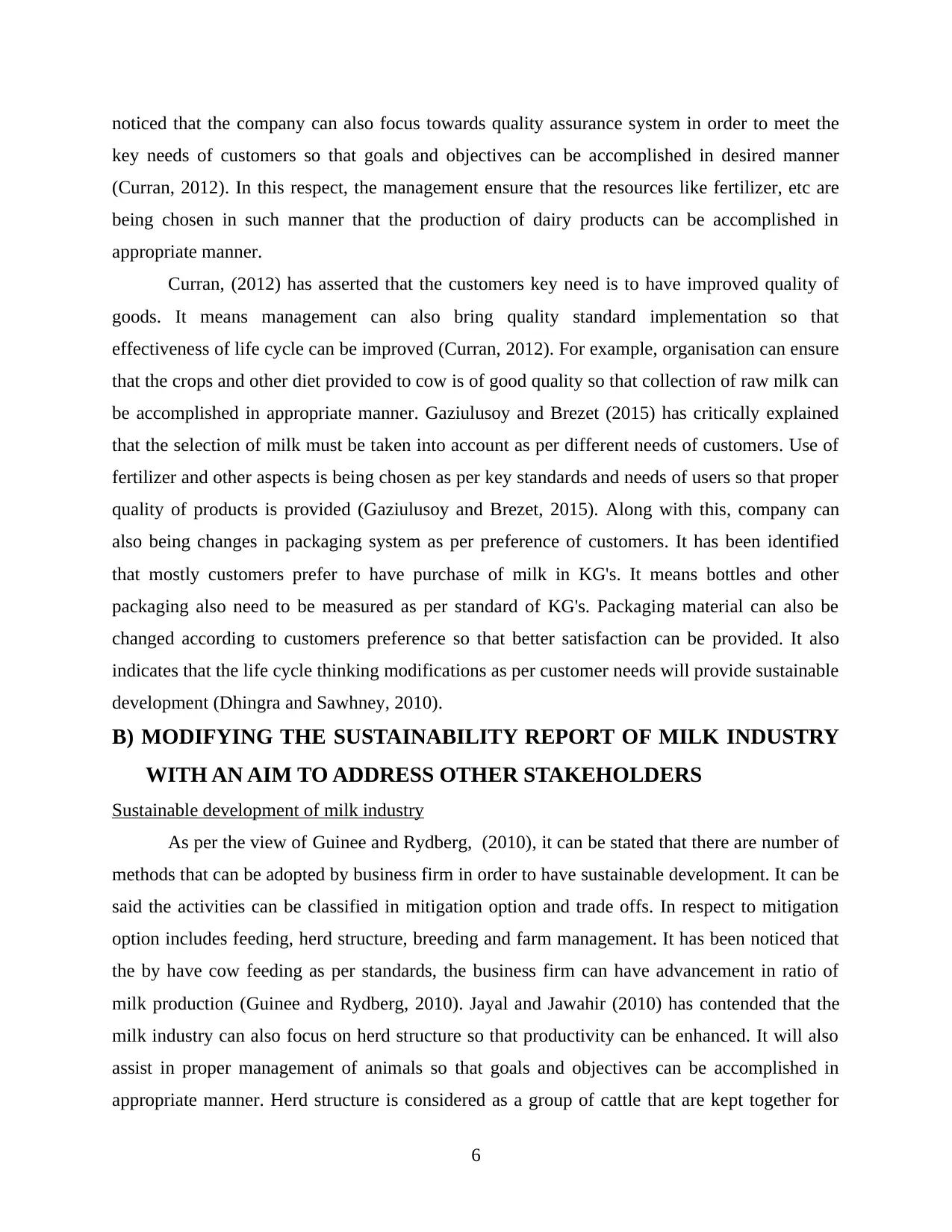
noticed that the company can also focus towards quality assurance system in order to meet the
key needs of customers so that goals and objectives can be accomplished in desired manner
(Curran, 2012). In this respect, the management ensure that the resources like fertilizer, etc are
being chosen in such manner that the production of dairy products can be accomplished in
appropriate manner.
Curran, (2012) has asserted that the customers key need is to have improved quality of
goods. It means management can also bring quality standard implementation so that
effectiveness of life cycle can be improved (Curran, 2012). For example, organisation can ensure
that the crops and other diet provided to cow is of good quality so that collection of raw milk can
be accomplished in appropriate manner. Gaziulusoy and Brezet (2015) has critically explained
that the selection of milk must be taken into account as per different needs of customers. Use of
fertilizer and other aspects is being chosen as per key standards and needs of users so that proper
quality of products is provided (Gaziulusoy and Brezet, 2015). Along with this, company can
also being changes in packaging system as per preference of customers. It has been identified
that mostly customers prefer to have purchase of milk in KG's. It means bottles and other
packaging also need to be measured as per standard of KG's. Packaging material can also be
changed according to customers preference so that better satisfaction can be provided. It also
indicates that the life cycle thinking modifications as per customer needs will provide sustainable
development (Dhingra and Sawhney, 2010).
B) MODIFYING THE SUSTAINABILITY REPORT OF MILK INDUSTRY
WITH AN AIM TO ADDRESS OTHER STAKEHOLDERS
Sustainable development of milk industry
As per the view of Guinee and Rydberg, (2010), it can be stated that there are number of
methods that can be adopted by business firm in order to have sustainable development. It can be
said the activities can be classified in mitigation option and trade offs. In respect to mitigation
option includes feeding, herd structure, breeding and farm management. It has been noticed that
the by have cow feeding as per standards, the business firm can have advancement in ratio of
milk production (Guinee and Rydberg, 2010). Jayal and Jawahir (2010) has contended that the
milk industry can also focus on herd structure so that productivity can be enhanced. It will also
assist in proper management of animals so that goals and objectives can be accomplished in
appropriate manner. Herd structure is considered as a group of cattle that are kept together for
6
key needs of customers so that goals and objectives can be accomplished in desired manner
(Curran, 2012). In this respect, the management ensure that the resources like fertilizer, etc are
being chosen in such manner that the production of dairy products can be accomplished in
appropriate manner.
Curran, (2012) has asserted that the customers key need is to have improved quality of
goods. It means management can also bring quality standard implementation so that
effectiveness of life cycle can be improved (Curran, 2012). For example, organisation can ensure
that the crops and other diet provided to cow is of good quality so that collection of raw milk can
be accomplished in appropriate manner. Gaziulusoy and Brezet (2015) has critically explained
that the selection of milk must be taken into account as per different needs of customers. Use of
fertilizer and other aspects is being chosen as per key standards and needs of users so that proper
quality of products is provided (Gaziulusoy and Brezet, 2015). Along with this, company can
also being changes in packaging system as per preference of customers. It has been identified
that mostly customers prefer to have purchase of milk in KG's. It means bottles and other
packaging also need to be measured as per standard of KG's. Packaging material can also be
changed according to customers preference so that better satisfaction can be provided. It also
indicates that the life cycle thinking modifications as per customer needs will provide sustainable
development (Dhingra and Sawhney, 2010).
B) MODIFYING THE SUSTAINABILITY REPORT OF MILK INDUSTRY
WITH AN AIM TO ADDRESS OTHER STAKEHOLDERS
Sustainable development of milk industry
As per the view of Guinee and Rydberg, (2010), it can be stated that there are number of
methods that can be adopted by business firm in order to have sustainable development. It can be
said the activities can be classified in mitigation option and trade offs. In respect to mitigation
option includes feeding, herd structure, breeding and farm management. It has been noticed that
the by have cow feeding as per standards, the business firm can have advancement in ratio of
milk production (Guinee and Rydberg, 2010). Jayal and Jawahir (2010) has contended that the
milk industry can also focus on herd structure so that productivity can be enhanced. It will also
assist in proper management of animals so that goals and objectives can be accomplished in
appropriate manner. Herd structure is considered as a group of cattle that are kept together for
6
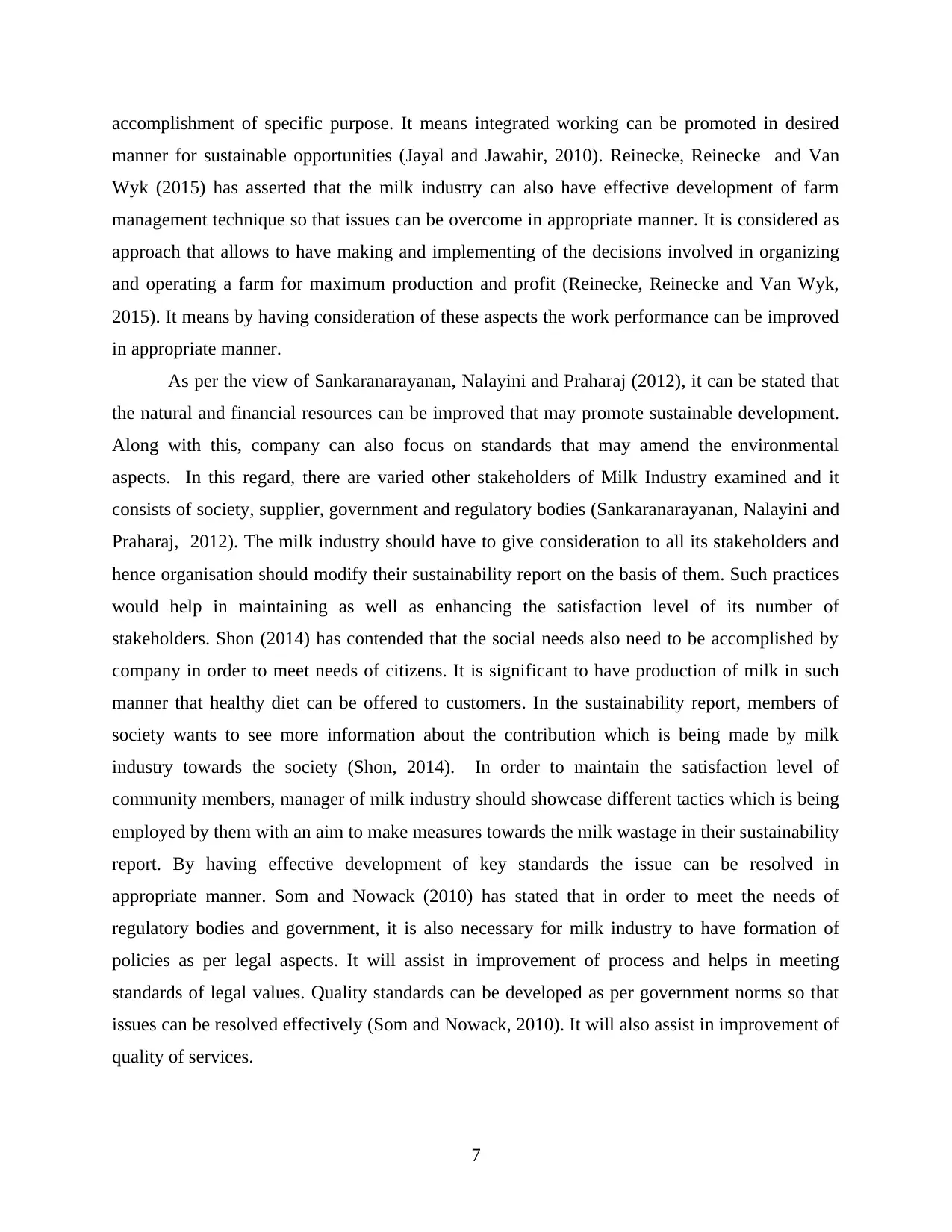
accomplishment of specific purpose. It means integrated working can be promoted in desired
manner for sustainable opportunities (Jayal and Jawahir, 2010). Reinecke, Reinecke and Van
Wyk (2015) has asserted that the milk industry can also have effective development of farm
management technique so that issues can be overcome in appropriate manner. It is considered as
approach that allows to have making and implementing of the decisions involved in organizing
and operating a farm for maximum production and profit (Reinecke, Reinecke and Van Wyk,
2015). It means by having consideration of these aspects the work performance can be improved
in appropriate manner.
As per the view of Sankaranarayanan, Nalayini and Praharaj (2012), it can be stated that
the natural and financial resources can be improved that may promote sustainable development.
Along with this, company can also focus on standards that may amend the environmental
aspects. In this regard, there are varied other stakeholders of Milk Industry examined and it
consists of society, supplier, government and regulatory bodies (Sankaranarayanan, Nalayini and
Praharaj, 2012). The milk industry should have to give consideration to all its stakeholders and
hence organisation should modify their sustainability report on the basis of them. Such practices
would help in maintaining as well as enhancing the satisfaction level of its number of
stakeholders. Shon (2014) has contended that the social needs also need to be accomplished by
company in order to meet needs of citizens. It is significant to have production of milk in such
manner that healthy diet can be offered to customers. In the sustainability report, members of
society wants to see more information about the contribution which is being made by milk
industry towards the society (Shon, 2014). In order to maintain the satisfaction level of
community members, manager of milk industry should showcase different tactics which is being
employed by them with an aim to make measures towards the milk wastage in their sustainability
report. By having effective development of key standards the issue can be resolved in
appropriate manner. Som and Nowack (2010) has stated that in order to meet the needs of
regulatory bodies and government, it is also necessary for milk industry to have formation of
policies as per legal aspects. It will assist in improvement of process and helps in meeting
standards of legal values. Quality standards can be developed as per government norms so that
issues can be resolved effectively (Som and Nowack, 2010). It will also assist in improvement of
quality of services.
7
manner for sustainable opportunities (Jayal and Jawahir, 2010). Reinecke, Reinecke and Van
Wyk (2015) has asserted that the milk industry can also have effective development of farm
management technique so that issues can be overcome in appropriate manner. It is considered as
approach that allows to have making and implementing of the decisions involved in organizing
and operating a farm for maximum production and profit (Reinecke, Reinecke and Van Wyk,
2015). It means by having consideration of these aspects the work performance can be improved
in appropriate manner.
As per the view of Sankaranarayanan, Nalayini and Praharaj (2012), it can be stated that
the natural and financial resources can be improved that may promote sustainable development.
Along with this, company can also focus on standards that may amend the environmental
aspects. In this regard, there are varied other stakeholders of Milk Industry examined and it
consists of society, supplier, government and regulatory bodies (Sankaranarayanan, Nalayini and
Praharaj, 2012). The milk industry should have to give consideration to all its stakeholders and
hence organisation should modify their sustainability report on the basis of them. Such practices
would help in maintaining as well as enhancing the satisfaction level of its number of
stakeholders. Shon (2014) has contended that the social needs also need to be accomplished by
company in order to meet needs of citizens. It is significant to have production of milk in such
manner that healthy diet can be offered to customers. In the sustainability report, members of
society wants to see more information about the contribution which is being made by milk
industry towards the society (Shon, 2014). In order to maintain the satisfaction level of
community members, manager of milk industry should showcase different tactics which is being
employed by them with an aim to make measures towards the milk wastage in their sustainability
report. By having effective development of key standards the issue can be resolved in
appropriate manner. Som and Nowack (2010) has stated that in order to meet the needs of
regulatory bodies and government, it is also necessary for milk industry to have formation of
policies as per legal aspects. It will assist in improvement of process and helps in meeting
standards of legal values. Quality standards can be developed as per government norms so that
issues can be resolved effectively (Som and Nowack, 2010). It will also assist in improvement of
quality of services.
7
⊘ This is a preview!⊘
Do you want full access?
Subscribe today to unlock all pages.

Trusted by 1+ million students worldwide
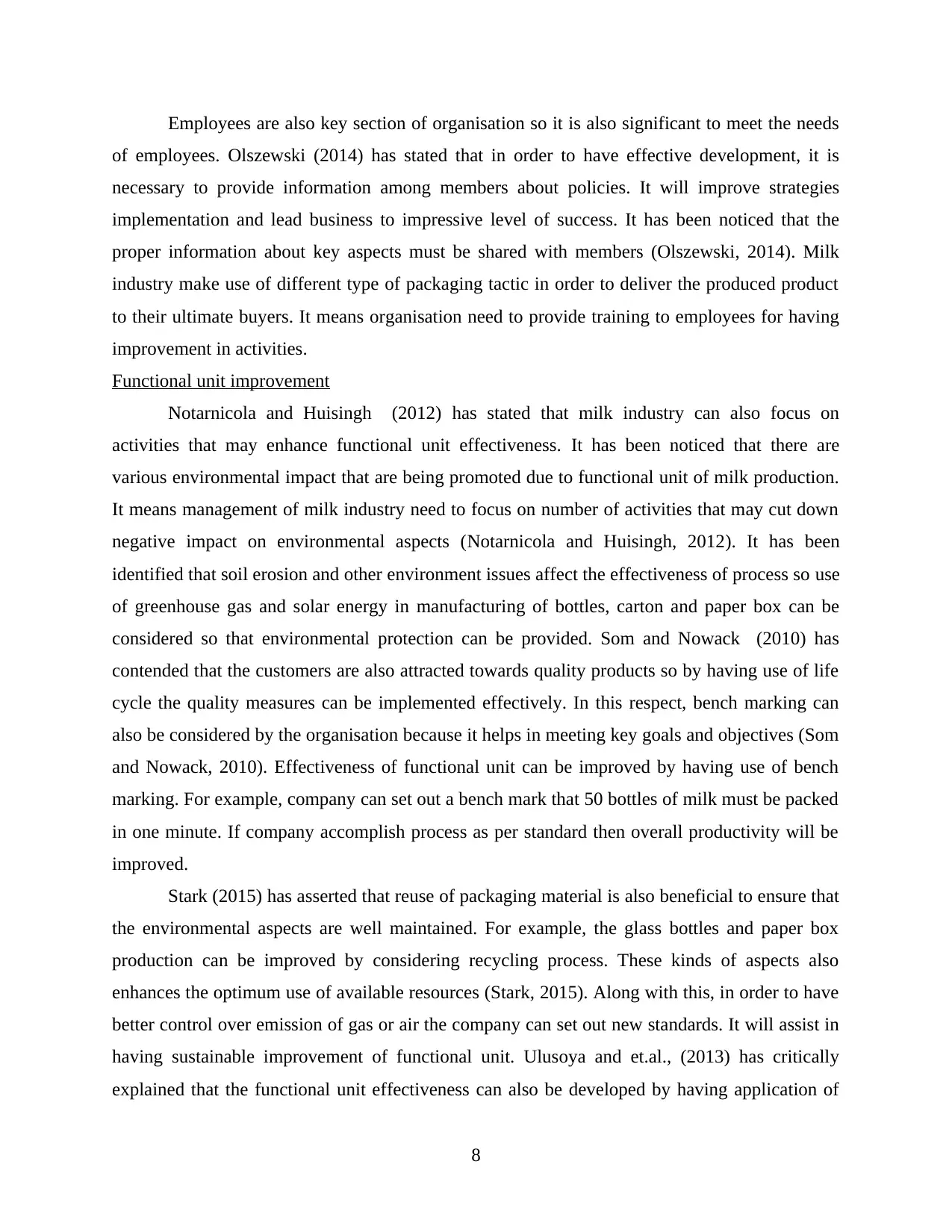
Employees are also key section of organisation so it is also significant to meet the needs
of employees. Olszewski (2014) has stated that in order to have effective development, it is
necessary to provide information among members about policies. It will improve strategies
implementation and lead business to impressive level of success. It has been noticed that the
proper information about key aspects must be shared with members (Olszewski, 2014). Milk
industry make use of different type of packaging tactic in order to deliver the produced product
to their ultimate buyers. It means organisation need to provide training to employees for having
improvement in activities.
Functional unit improvement
Notarnicola and Huisingh (2012) has stated that milk industry can also focus on
activities that may enhance functional unit effectiveness. It has been noticed that there are
various environmental impact that are being promoted due to functional unit of milk production.
It means management of milk industry need to focus on number of activities that may cut down
negative impact on environmental aspects (Notarnicola and Huisingh, 2012). It has been
identified that soil erosion and other environment issues affect the effectiveness of process so use
of greenhouse gas and solar energy in manufacturing of bottles, carton and paper box can be
considered so that environmental protection can be provided. Som and Nowack (2010) has
contended that the customers are also attracted towards quality products so by having use of life
cycle the quality measures can be implemented effectively. In this respect, bench marking can
also be considered by the organisation because it helps in meeting key goals and objectives (Som
and Nowack, 2010). Effectiveness of functional unit can be improved by having use of bench
marking. For example, company can set out a bench mark that 50 bottles of milk must be packed
in one minute. If company accomplish process as per standard then overall productivity will be
improved.
Stark (2015) has asserted that reuse of packaging material is also beneficial to ensure that
the environmental aspects are well maintained. For example, the glass bottles and paper box
production can be improved by considering recycling process. These kinds of aspects also
enhances the optimum use of available resources (Stark, 2015). Along with this, in order to have
better control over emission of gas or air the company can set out new standards. It will assist in
having sustainable improvement of functional unit. Ulusoya and et.al., (2013) has critically
explained that the functional unit effectiveness can also be developed by having application of
8
of employees. Olszewski (2014) has stated that in order to have effective development, it is
necessary to provide information among members about policies. It will improve strategies
implementation and lead business to impressive level of success. It has been noticed that the
proper information about key aspects must be shared with members (Olszewski, 2014). Milk
industry make use of different type of packaging tactic in order to deliver the produced product
to their ultimate buyers. It means organisation need to provide training to employees for having
improvement in activities.
Functional unit improvement
Notarnicola and Huisingh (2012) has stated that milk industry can also focus on
activities that may enhance functional unit effectiveness. It has been noticed that there are
various environmental impact that are being promoted due to functional unit of milk production.
It means management of milk industry need to focus on number of activities that may cut down
negative impact on environmental aspects (Notarnicola and Huisingh, 2012). It has been
identified that soil erosion and other environment issues affect the effectiveness of process so use
of greenhouse gas and solar energy in manufacturing of bottles, carton and paper box can be
considered so that environmental protection can be provided. Som and Nowack (2010) has
contended that the customers are also attracted towards quality products so by having use of life
cycle the quality measures can be implemented effectively. In this respect, bench marking can
also be considered by the organisation because it helps in meeting key goals and objectives (Som
and Nowack, 2010). Effectiveness of functional unit can be improved by having use of bench
marking. For example, company can set out a bench mark that 50 bottles of milk must be packed
in one minute. If company accomplish process as per standard then overall productivity will be
improved.
Stark (2015) has asserted that reuse of packaging material is also beneficial to ensure that
the environmental aspects are well maintained. For example, the glass bottles and paper box
production can be improved by considering recycling process. These kinds of aspects also
enhances the optimum use of available resources (Stark, 2015). Along with this, in order to have
better control over emission of gas or air the company can set out new standards. It will assist in
having sustainable improvement of functional unit. Ulusoya and et.al., (2013) has critically
explained that the functional unit effectiveness can also be developed by having application of
8
Paraphrase This Document
Need a fresh take? Get an instant paraphrase of this document with our AI Paraphraser
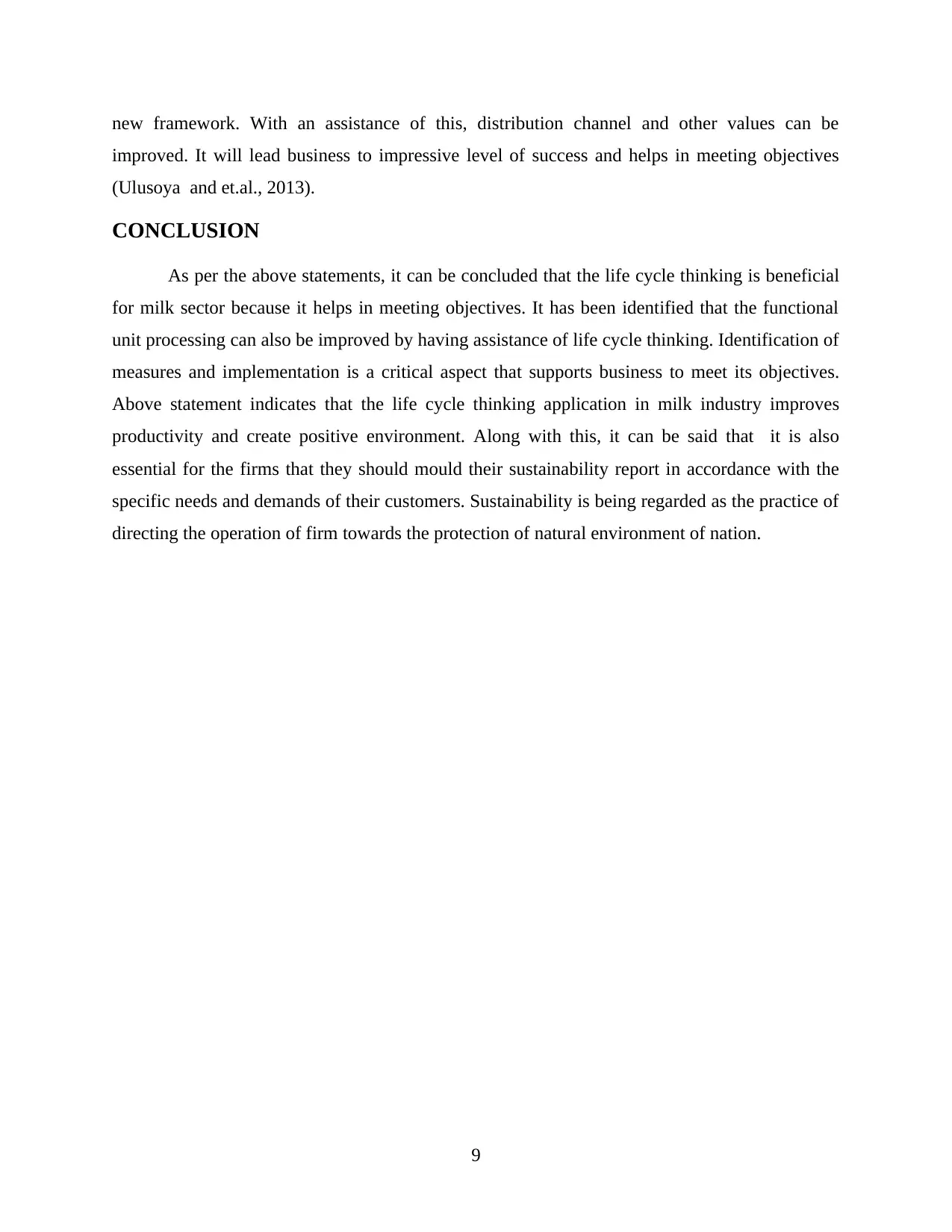
new framework. With an assistance of this, distribution channel and other values can be
improved. It will lead business to impressive level of success and helps in meeting objectives
(Ulusoya and et.al., 2013).
CONCLUSION
As per the above statements, it can be concluded that the life cycle thinking is beneficial
for milk sector because it helps in meeting objectives. It has been identified that the functional
unit processing can also be improved by having assistance of life cycle thinking. Identification of
measures and implementation is a critical aspect that supports business to meet its objectives.
Above statement indicates that the life cycle thinking application in milk industry improves
productivity and create positive environment. Along with this, it can be said that it is also
essential for the firms that they should mould their sustainability report in accordance with the
specific needs and demands of their customers. Sustainability is being regarded as the practice of
directing the operation of firm towards the protection of natural environment of nation.
9
improved. It will lead business to impressive level of success and helps in meeting objectives
(Ulusoya and et.al., 2013).
CONCLUSION
As per the above statements, it can be concluded that the life cycle thinking is beneficial
for milk sector because it helps in meeting objectives. It has been identified that the functional
unit processing can also be improved by having assistance of life cycle thinking. Identification of
measures and implementation is a critical aspect that supports business to meet its objectives.
Above statement indicates that the life cycle thinking application in milk industry improves
productivity and create positive environment. Along with this, it can be said that it is also
essential for the firms that they should mould their sustainability report in accordance with the
specific needs and demands of their customers. Sustainability is being regarded as the practice of
directing the operation of firm towards the protection of natural environment of nation.
9
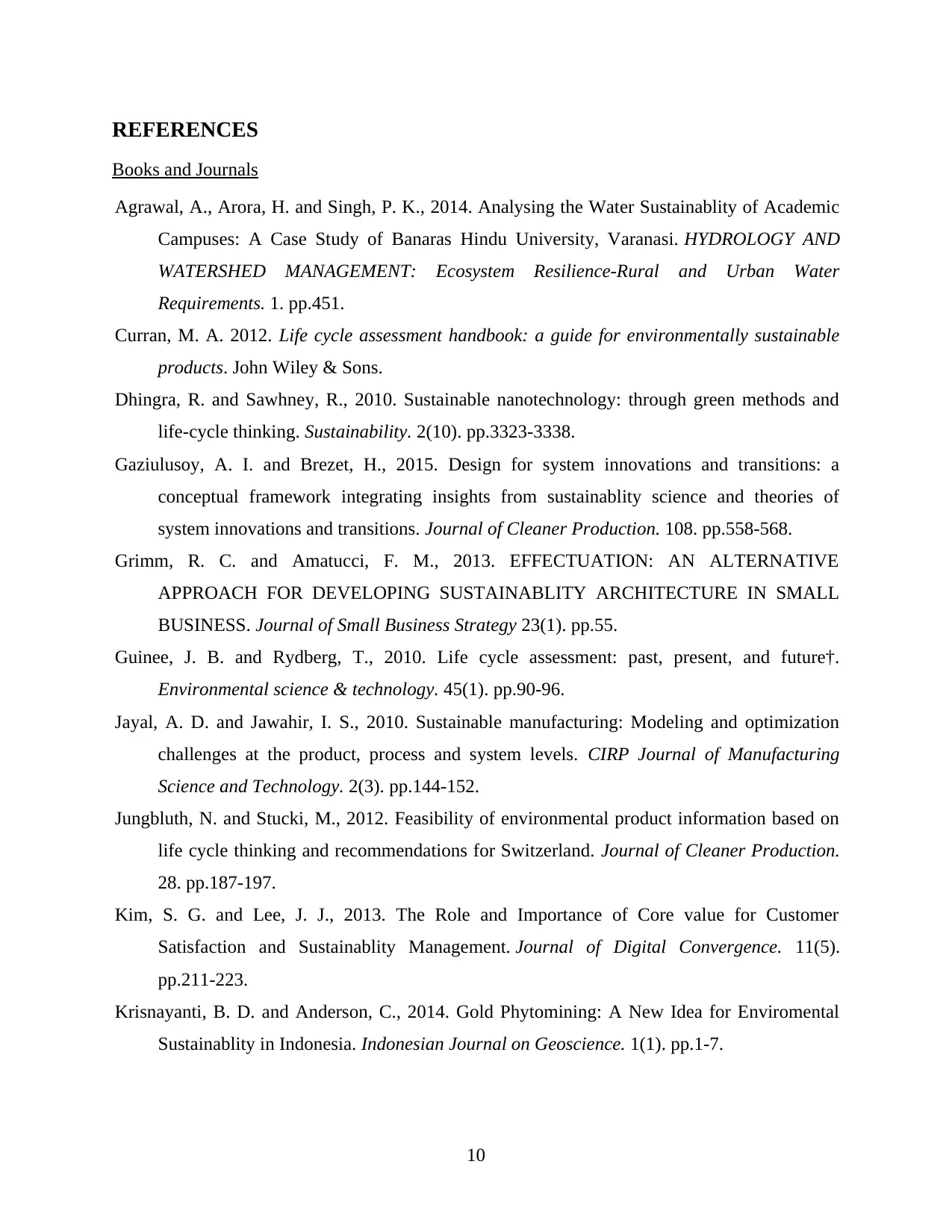
REFERENCES
Books and Journals
Agrawal, A., Arora, H. and Singh, P. K., 2014. Analysing the Water Sustainablity of Academic
Campuses: A Case Study of Banaras Hindu University, Varanasi. HYDROLOGY AND
WATERSHED MANAGEMENT: Ecosystem Resilience-Rural and Urban Water
Requirements. 1. pp.451.
Curran, M. A. 2012. Life cycle assessment handbook: a guide for environmentally sustainable
products. John Wiley & Sons.
Dhingra, R. and Sawhney, R., 2010. Sustainable nanotechnology: through green methods and
life-cycle thinking. Sustainability. 2(10). pp.3323-3338.
Gaziulusoy, A. I. and Brezet, H., 2015. Design for system innovations and transitions: a
conceptual framework integrating insights from sustainablity science and theories of
system innovations and transitions. Journal of Cleaner Production. 108. pp.558-568.
Grimm, R. C. and Amatucci, F. M., 2013. EFFECTUATION: AN ALTERNATIVE
APPROACH FOR DEVELOPING SUSTAINABLITY ARCHITECTURE IN SMALL
BUSINESS. Journal of Small Business Strategy 23(1). pp.55.
Guinee, J. B. and Rydberg, T., 2010. Life cycle assessment: past, present, and future†.
Environmental science & technology. 45(1). pp.90-96.
Jayal, A. D. and Jawahir, I. S., 2010. Sustainable manufacturing: Modeling and optimization
challenges at the product, process and system levels. CIRP Journal of Manufacturing
Science and Technology. 2(3). pp.144-152.
Jungbluth, N. and Stucki, M., 2012. Feasibility of environmental product information based on
life cycle thinking and recommendations for Switzerland. Journal of Cleaner Production.
28. pp.187-197.
Kim, S. G. and Lee, J. J., 2013. The Role and Importance of Core value for Customer
Satisfaction and Sustainablity Management. Journal of Digital Convergence. 11(5).
pp.211-223.
Krisnayanti, B. D. and Anderson, C., 2014. Gold Phytomining: A New Idea for Enviromental
Sustainablity in Indonesia. Indonesian Journal on Geoscience. 1(1). pp.1-7.
10
Books and Journals
Agrawal, A., Arora, H. and Singh, P. K., 2014. Analysing the Water Sustainablity of Academic
Campuses: A Case Study of Banaras Hindu University, Varanasi. HYDROLOGY AND
WATERSHED MANAGEMENT: Ecosystem Resilience-Rural and Urban Water
Requirements. 1. pp.451.
Curran, M. A. 2012. Life cycle assessment handbook: a guide for environmentally sustainable
products. John Wiley & Sons.
Dhingra, R. and Sawhney, R., 2010. Sustainable nanotechnology: through green methods and
life-cycle thinking. Sustainability. 2(10). pp.3323-3338.
Gaziulusoy, A. I. and Brezet, H., 2015. Design for system innovations and transitions: a
conceptual framework integrating insights from sustainablity science and theories of
system innovations and transitions. Journal of Cleaner Production. 108. pp.558-568.
Grimm, R. C. and Amatucci, F. M., 2013. EFFECTUATION: AN ALTERNATIVE
APPROACH FOR DEVELOPING SUSTAINABLITY ARCHITECTURE IN SMALL
BUSINESS. Journal of Small Business Strategy 23(1). pp.55.
Guinee, J. B. and Rydberg, T., 2010. Life cycle assessment: past, present, and future†.
Environmental science & technology. 45(1). pp.90-96.
Jayal, A. D. and Jawahir, I. S., 2010. Sustainable manufacturing: Modeling and optimization
challenges at the product, process and system levels. CIRP Journal of Manufacturing
Science and Technology. 2(3). pp.144-152.
Jungbluth, N. and Stucki, M., 2012. Feasibility of environmental product information based on
life cycle thinking and recommendations for Switzerland. Journal of Cleaner Production.
28. pp.187-197.
Kim, S. G. and Lee, J. J., 2013. The Role and Importance of Core value for Customer
Satisfaction and Sustainablity Management. Journal of Digital Convergence. 11(5).
pp.211-223.
Krisnayanti, B. D. and Anderson, C., 2014. Gold Phytomining: A New Idea for Enviromental
Sustainablity in Indonesia. Indonesian Journal on Geoscience. 1(1). pp.1-7.
10
⊘ This is a preview!⊘
Do you want full access?
Subscribe today to unlock all pages.

Trusted by 1+ million students worldwide
1 out of 14
Related Documents
Your All-in-One AI-Powered Toolkit for Academic Success.
+13062052269
info@desklib.com
Available 24*7 on WhatsApp / Email
![[object Object]](/_next/static/media/star-bottom.7253800d.svg)
Unlock your academic potential
Copyright © 2020–2025 A2Z Services. All Rights Reserved. Developed and managed by ZUCOL.




